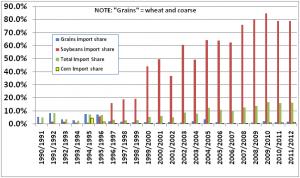Here is a look at China’s self-sufficiency rate for grains and oilseeds (other than rice) with soybeans and corn also shown separately. There is occasional talk in China about what level of self-sufficiency they can accept, and 95 percent is often mentioned, along with the idea that may they can settle for 90 percent self-sufficiency. The chart to the left shows that China has decided they do not need to be self-sufficient in soybeans.
What will China accept for corn? China has a much stronger commitment to corn production than to soybean production.
In the chart (above), if China is setting goals for a self-sufficiency level of ‘other grains + oilseeds’ they already are at 16 percent import share.
But if they separate the soybeans out, for all grains (excluding rice) they are only at 1.6 percent, and a 95 percent self-sufficiency policy would allow for 15 million metric tons of grain imports (mainly corn, wheat, barley). A 95 percent self-sufficiency in corn will allow for 8 million metric tons of imports. And a 90 percent self-sufficiency goal will allow for 16 million metric tons of imports.



